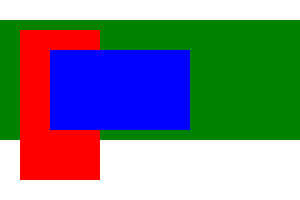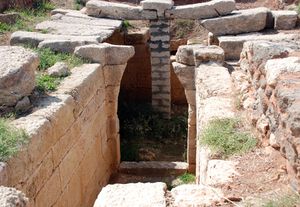قالب:جدول موقع قديم/شرح
Usage
To use this template, simply copy the text from the box below, paste it at the top of your article, then complete any of the parameters which apply to the archaeological site which you are describing. Only a value for the "name" parameter is required; all others are optional.
Use as few or many of the following fields as you wish. Fields for which no information is provided will not be displayed in your infobox. The more fields for which you add information, the longer will be your infobox. Infoboxes which include data for a large number of fields can interfere with other elements of your article.
{{Infobox_ancient_site
|name = <!-- required -->
|native_name =
|alternate_name =
|image =
|imagealttext =
|caption =
|map_type =
|map_alt =
|latitude =
|longitude =
|map_size =
|location =
|region =
|coordinates =
|type =
|part_of =
|length =
|width =
|area =
|height =
|builder =
|material =
|built =
|abandoned =
|epochs =
|cultures =
|dependency_of =
|occupants =
|event =
|excavations =
|archaeologists =
|condition =
|ownership =
|public_access =
|website =
|notes =
}}
Parameter descriptions
Many of the titles displayed are broadly inclusive, and the descriptions below are suggestions. If you cannot find a description which exactly matches the information you wish to present, find the closest match. Again, only the "name" parameter is required.
- General information regarding the site or structure
- name = Name of the archaeological site or feature as spelled in English references (required)
- native_name = Name in the local language or spelling (this displays below title if present)
- alternate_name = Other name(s) by which the site is known
- image = Filename of image showing the site
- imagealttext = Alternative text describing the image
- caption = Text for a caption beneath image
- location = Area where located (nation, region and/or city)
- region = Use to specify a more localized region, province, quarter (e.g. Yucatan, Dorset, Attica, etc.)
- map_type = Regional map name
- map_alt = Alternative
- latitude = Latitude of the site
- longitude = Longitude of the site
- map_size = Width of map displayed (220 or smaller)
- coordinates = Use
{{coord|...|display=inline,title}}
- i.e. {{coord|50|01|01|N|90|01|01|W|region:US_type:landmark|display=inline,title}}
 >
- i.e. {{coord|50|01|01|N|90|01|01|W|region:US_type:landmark|display=inline,title}}
- type = Site type (tomb, fortification, encampment, temple, tumulus, settlement, etc.)
- part_of = Name of main site, if part of larger site or complex
- length = Length of site or remains (metric, if non-metric use a conversion template)
- width = Width of site or remains (metric)
- area = Area covered by the site or structure (metric)
- height = Greatest height of preserved remains (metric)
- History of the site or structure
- builder = If known, name of person or people who built the site
- material = Significant construction materials (stone, plaster, concrete, brick, wood)
- built = Year of construction: c. (circa) or period if year unknown
- abandoned = Year went out of use or destroyed: c. (circa) or period if year unknown
- epochs = Period(s) during which the site was in use (e.g., Bronze Age II–Iron Age I)
- cultures = Cultures which evidence has shown to have occupied the site
- dependency_of = If a satellite dependency (e.g., outlying village, quarry, etc.), specify the controlling nearby city or site
- occupants = Significant historical figures occupying or associated with the site
- event = Significant historical event(s) associated with the site
- Other information and notes about the site or structure
- excavations = Years for major excavation work
- archaeologists = Superintending archeologist(s)
- condition = Present condition of the remains (no extant remains, restored, ruined, etc.)
- ownership = Is the site on private or public property
- public_access = Is the site open to public visits (Yes, No, Limited)
- website = Use only if the site has an official web presence
- notes = any additional necessary explanatory notes
Example
Structure
 House of Potytles excavation (fictional) | |
| الاسم البديل | Potytleon |
|---|---|
| المكان | Izmir (Smyrna) |
| النوع | dwelling |
| جزء من | Acropolis |
| المساحة | 441.661 m² |
| التاريخ | |
| الباني | Hyxixus |
| المواد | stone |
| تأسس | c. 480 BCE |
| هـُـجـِر | c. 430 BCE |
| الفترات | Bronze II–Hellenistic |
| مقترن بـ | Potytles, Cimon |
| ملاحظات حول الموقع | |
| تواريخ الحفريات | 1908–1909, 2010– |
| الأثريون | Theodore Makridi Bey |
| الحالة | partial restoration |
| الاتاحة للعامة | No |
| active excavation | |
{{Infobox_ancient_site
|name = Palace of Potytles
|native_name =
|alternate_name = Potytleon
|image = Example svg.svg
|imagealttext = Looking down onto tumbled, colorful ashlars
|caption = House of Potytles excavation (fictional)
|map_type =
|map_alt =
|latitude =
|longitude =
|map_size =
|location = Izmir (Smyrna)
|region =
|coordinates =
|type = dwelling
|part_of = Acropolis
|length =
|width =
|area = 441.661 m²
|height =
|builder = Hyxixus
|material = stone
|built = c. 480 BCE
|abandoned = c. 430 BCE
|epochs = Bronze II–Hellenistic
|cultures =
|dependency_of =
|occupants = Potytles, [[Cimon]]
|event =
|excavations = 1908–1909, 2010–
|archaeologists = Theodore Makridi Bey
|condition = partial restoration
|ownership =
|public_access = No
|website =
|notes = active excavation
}}
Larger site
العربية: رأس ابن هاني | |
 A tomb at Ras Ibn Hani | |
| خطأ لوا في وحدة:Location_map على السطر 425: No value was provided for longitude. | |
| الاسم البديل | Betyllion |
|---|---|
| المكان | Latakia, Syria |
| النوع | settlement |
| المساحة | 2 hec |
| التاريخ | |
| الفترات | Late Bronze–Early Byzantine |
| الثقافات | Canaanite, Hellenistic, Roman |
| ساتل لـ | Ugarit |
| ملاحظات حول الموقع | |
| الملكية | Mixed public and private |
| الاتاحة للعامة | Partial |
| now is the site of Cote d'Azur | |
{{Infobox_ancient_site
|name = Ras Ibn Hani
|native_name = {{lang-ar|رأس ابن هاني}}
|alternate_name = Betyllion
|image = RasIbnHani,tomb1.jpg
|imagealttext = A corridor built of ashlars leads to a ruined archway
|caption = A tomb at Ras Ibn Hani
|map_type = Syria
|map_alt = Located on the Mediterranean coast of Syria
|latitude = 35.585
|longitude = 35.746
|map_size = 150
|location = [[Latakia]], [[Syria]]
|region =
|coordinates =
|type = settlement
|part_of =
|length =
|width =
|area = 2 hec
|height =
|builder =
|material =
|built =
|abandoned =
|epochs = Late Bronze–Early Byzantine
|cultures = Canaanite, Hellenistic, Roman
|dependency_of = [[Ugarit]]
|occupants =
|event =
|excavations =
|archaeologists =
|condition =
|ownership = Mixed public and private
|public_access = Partial
|website =
|notes = now is the site of [[Cote d'Azur, Syria|Cote d'Azur]]
}}
Microformat
The HTML mark up produced by this template includes an hCard microformat, which makes the place-name and location parsable by computers, either acting automatically to catalogue article across Wikipedia, or via a browser tool operated by a person, to (for example) add the subject to an address book. Within the hCard is a Geo microformat, which additionally makes the coordinates (latitude & longitude) parsable, so that they can be, say, looked up on a map, or downloaded to a GPS unit. For more information about the use of microformats on Wikipedia, please see the microformat project.
hCard uses HTML classes including:
- "adr"
- "county-name"
- "fn"
- "label"
- "locality"
- "nickname"
- "note"
- "org"
- "region"
- "street-address"
- "vcard"
Geo is produced by calling {{coord}}, and uses HTML classes:
- "geo"
- "latitude"
- "longitude"
Please do not rename or remove these classes.
When giving coordinates, please don't be overly precise.